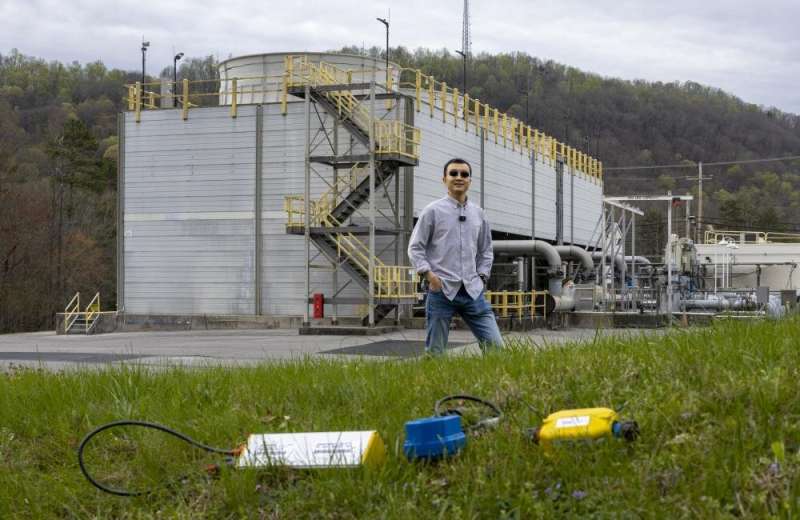Good vibrations: Seismic science draws clearer picture of clean energy

Like most scientists, Chengping Chai is not content with the surface of things: He wants to probe beyond to learn what’s really going on. But in his case, he is literally building a map of the world beneath, using seismic and acoustic data that reveal when and where the earth moves.
Yet earthquakes are not the focus of Chai’s research at the Department of Energy’s Oak Ridge National Laboratory. He is using these waves to make waves—creating new opportunities for developing clean energy and enhancing sensing capabilities around nuclear reactors.
Chai is a geophysicist who works closely with ORNL scientist Monica Maceira, a collaboration that began when Maceira was already managing ORNL’s seismology portfolio and Chai was a graduate student at Pennsylvania State University. Chai initially used seismic imaging at different scales to better pinpoint earthquake epicenters. But since joining ORNL’s Energy Sciences and Technology Directorate in 2018, he has shifted his focus in new directions—even though they all point down under his feet.
Clean energy generation, carbon storage
How does seismology relate to clean energy? It is foundational to the safe operation of both geothermal energy and carbon storage, two groundbreaking approaches for reducing atmospheric carbon dioxide that drives climate change.
Geothermal power plants use heated water from deep inside the earth to create steam that drives a turbine to generate electrical current. Unlike power plants that burn fossil fuels, geothermal plants don’t release greenhouse gases.
Atmospheric carbon dioxide can also be reduced through storage in underground caves or reservoirs, trapped by a “lid” of solid rock. Carbon dioxide slowly combines with subterranean water or minerals in the rock.
Both carbon storage and geothermal energy projects require understanding underground spaces where fissures are located and where the earth moves. These questions are answered primarily with seismic and acoustic sensing.
“We need to use these tools before, during and after these projects occur,” Chai said. “We need to understand the subsurface for choosing sites and drilling boreholes. During the pumping of water or carbon dioxide, we need to monitor how the fluid is moving and how the fracture is going. And afterward, we need to see if the fracture remains as intended or is evolving the way we want.”
Accurate seismic information enhances both safety and the effectiveness of operations. For example, geothermal projects rely on generating a network of large but stable fractures. More accurate mapping of fractures could help enhance the capacity of geothermal power plants.
Chai developed cutting-edge machine learning techniques and advanced seismic data processing algorithms using data sets from Oklahoma earthquakes. He applied physics and artificial intelligence to create high-resolution, 3D images of the subsurface.
Maceira said that Oklahoma’s uptick in earthquake activity coincided with the introduction of fracking, which injects liquid and sand into the ground to force out oil or natural gas. These quake records provide insight into human-induced seismic activity, which can be applied to analytic tools for clean energy projects.
“All these types of energy production involve extracting something from the underground or injecting something in the underground,” Maceira said. “That causes a change in the state of stress, which can induce earthquakes. Seismic data is key to being able to alert operators and keep people safe. The goal is getting higher-resolution information faster, with the ultimate goal being real time.” That could enable on-the-spot decisions about altering operations to prevent earthquakes.
Today’s current process for high-precision seismic analysis is so labor intensive that it takes months or even years. Chai is still refining his technique, but for a single step of the analysis, his deep-learning approach detected more seismic events and took 99.9% less time.
Understanding nuclear reactor activity
Monitoring nuclear reactors is an important safety and security task with growing requirements. Verifying that a nuclear reactor is operating as declared is of value to the nuclear nonproliferation community. Chai and Maceira, who works in the National Security Sciences Directorate, have been developing ways to use seismic and sound waves to infer the power level of an operating reactor.
Chai developed machine learning models for recognizing from a distance when the High Flux Isotope Reactor, or HFIR, at ORNL was operating. He and a research team built on the approach to be equally effective at recognizing the operating condition of the Advanced Test Reactor at Idaho National Laboratory.
A persistent challenge was maintaining accuracy when other large pieces of equipment, such as valves and pumps, were running, too. Vibration sources so close to each other create interference. So, after deploying seismic stations around the HFIR cooling tower, the team developed a new technique using amplitude and polarization of the seismic signals to pinpoint the location of different vibration sources.
Maceira said when seismic research began at HFIR in 2017, the team had no idea if seismo-acoustic sensing would work for monitoring a nuclear reactor. Since then, others have seen how seismic results can be combined with other observations to increase confidence in monitoring conclusions. Seismic team members are now consulted as subject matter experts in nonproliferation.
Citation:
Good vibrations: Seismic science draws clearer picture of clean energy (2023, June 12)
retrieved 12 June 2023
from https://techxplore.com/news/2023-06-good-vibrations-seismic-science-clearer.html
This document is subject to copyright. Apart from any fair dealing for the purpose of private study or research, no
part may be reproduced without the written permission. The content is provided for information purposes only.
For all the latest Technology News Click Here
For the latest news and updates, follow us on Google News.
